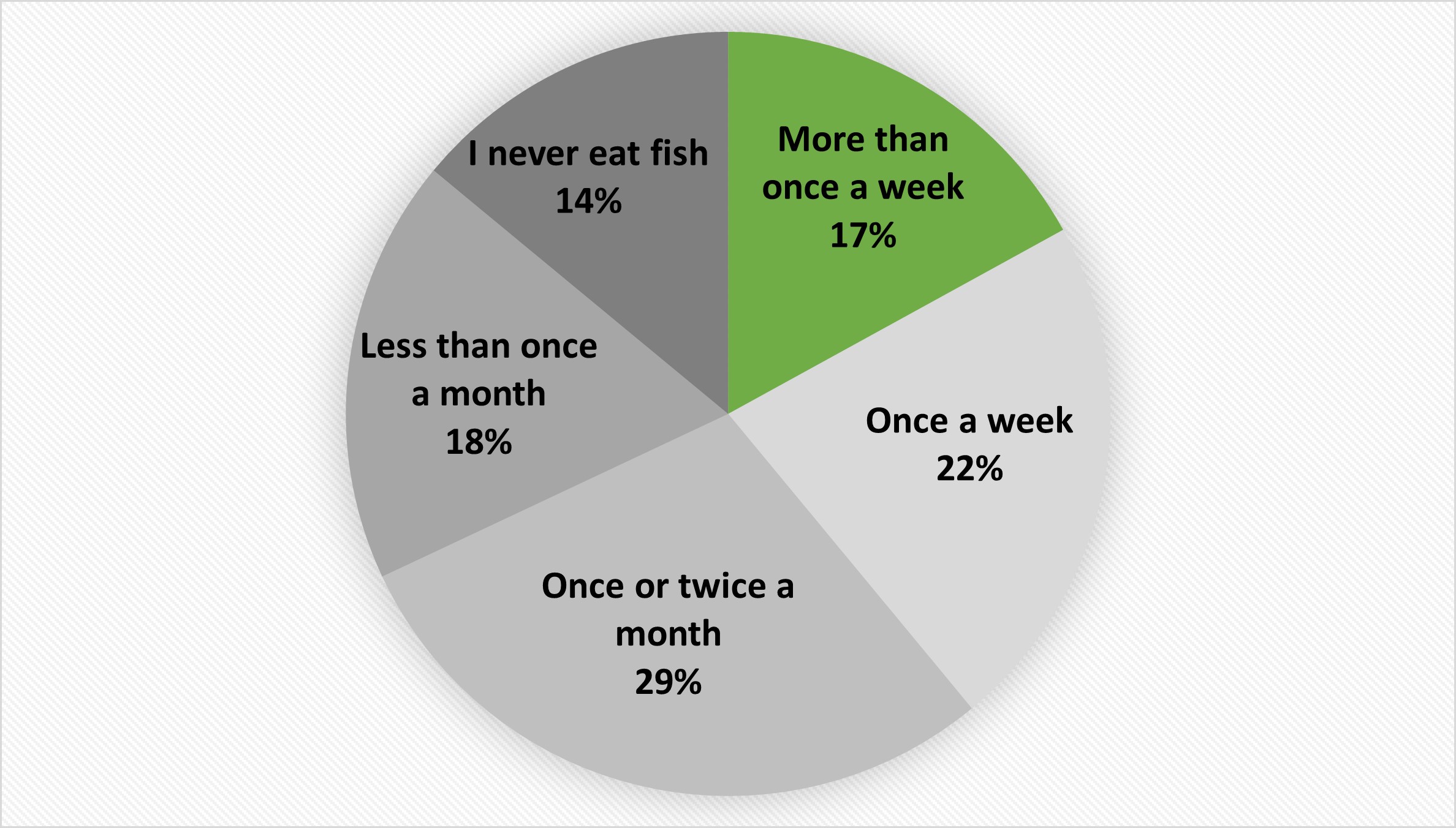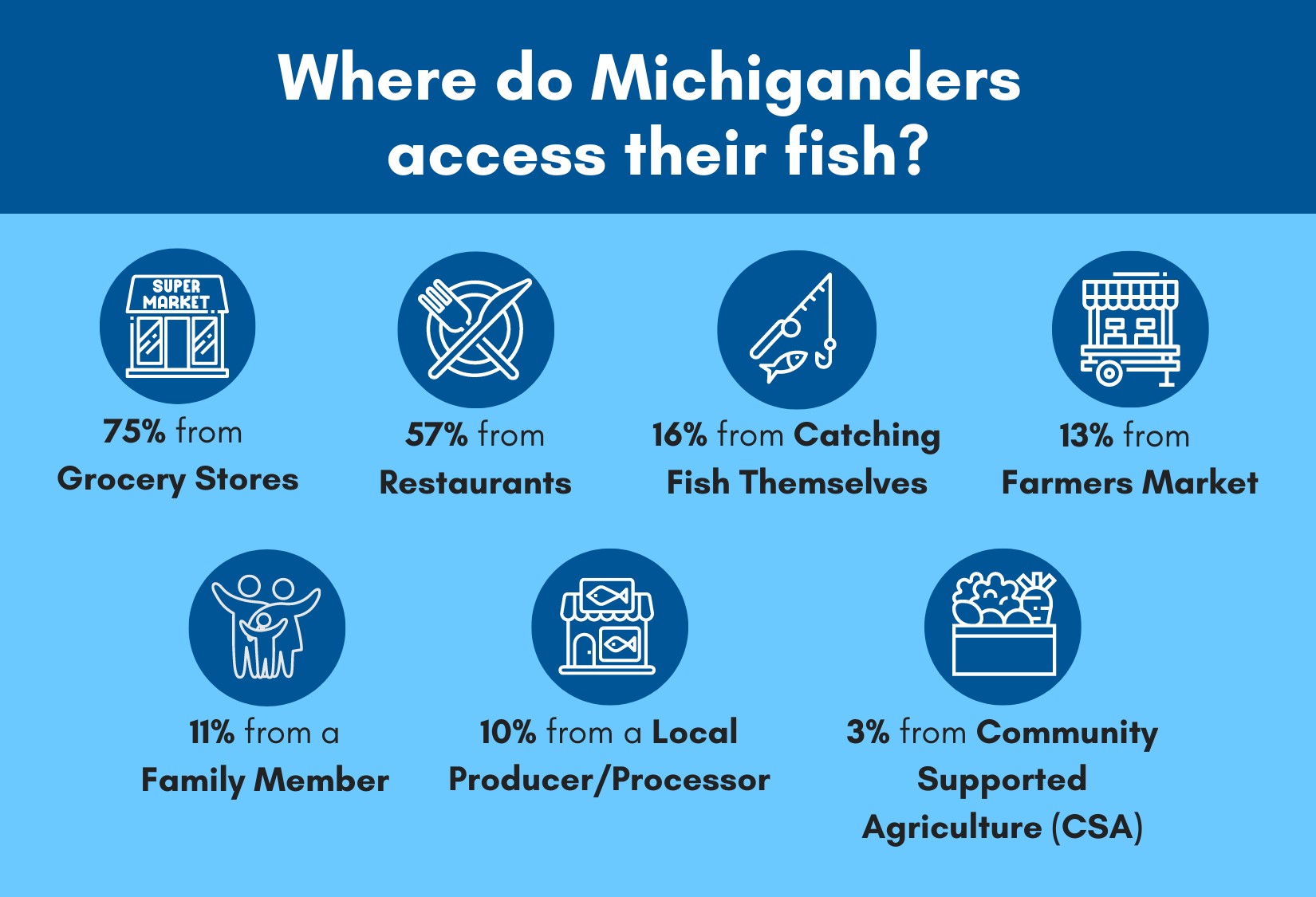How often do Michiganders eat fish?
Michigan consumer survey offers insight about seafood consumption.

Did you know fish is one of the healthiest protein sources in the world? A 3 oz. serving of fish has nearly 1/3 of our daily protein requirements, with very little fat. What fat fish does have is often considered healthy such as omega-3 fatty acids. The U.S. Department of Health and Human Services recommends eating seafood two times a week because it is a nutrient-rich food containing high-quality protein, long-chain polyunsaturated fatty acids (omega-3), and important vitamins and minerals. It might be expected that Michiganders eat their recommended weekly amounts of fish (as the Great Lakes region has a sustainable fishery in addition to aquaculture farms providing fish for food), but research suggests many Americans, including Michigan residents, do not eat fish as often as they should. To help develop an understanding of markets for local fish as food and Michiganders preferences, Michigan Sea Grant recently partnered to deliver a preliminary study on seafood consumption for Michigan.
In November 2022, Michigan State University Extension Sea Grant educator Lauren Jescovitch worked with the team at Monte Consulting in Houghton, Mich., to organize a Michigan seafood consumer survey to use as marketing research for fish production and processing industries. The survey had 205 responses, equally distributed across ages (18 and older), gender, and household income. Household sizes varied, but more than half had two to three family members.
How often do Michiganders eat fish?
Figure 2 showcases one of the most important findings from this study - Michigan residents do not eat the recommended amount of fish. According to survey results, just 17% eat fish more than once a week as recommended by the US Department of Health and Human Services. An additional 22% eat fish once a week, leaving more than 60% eating fish on rare occasions or never. For those who rarely or never eat fish, the majority said that it is expensive, 25% said they didn’t grow up eating fish, and another 25% said it is difficult to cook.

Even though most Michigan residents do not eat fish often, many do enjoy the occasional fish dish. Some of the reasons people eat fish, according to the survey, include the enjoyable taste and the health benefits. Baked and fried fish are the way most people like to eat fish. Preparing it by broiling, smoking, or eating sushi follow as the next popular choices.
Of the survey respondents, grocery stores (75%) and restaurants (57%) are where they buy fish. Although Michigan is renown for sportfishing, only 16% reported getting fish by catching it themselves, or are subsistence fishers. Other options mentioned included farmer’s markets (13%), from a family member (11%), local producer/processor (10%), and community supported agriculture programs (CSA, 3%).
What would encourage Michiganders to eat more fish?
Factors that influence buying fish, from most important to least important, include: price, freshness, availability, where it comes from, and harvest method. Most Michiganders prefer their fish come specifically from Michigan.

A lower price would encourage 56% of respondents to eat more fish. Also, more availability would encourage 47% to eat more. The top five species people prefer include salmon, lake whitefish, yellow perch, walleye, and tilapia. In addition, 44% of respondents said they prefer fish to be wild-caught, while 42% said that they don’t have a preference between farm-raised or wild-caught. Some respondents (15%) said they preferred farm-raised. According to NOAA, the U.S. imports approximately 90% of our seafood and total global production is 50% wild-caught and 50% farm-raised. Therefore, aquaculture is available to supplement wild-caught fish for sustainability and food security.
The survey also provided the opportunity for respondents to provide perceptions of farm-raised and wild-caught fish. Many respondents knew very little to nothing about these practices and noted as such, including not knowing that both types of producers exist in Michigan. Others mentioned having perceptions on topics such as sustainability, nutrition, overfishing, contaminants, antibiotics, and freshness.
While further research would be needed to understand more about the respondents answers and perceptions, this preliminary study provides an opportunity to guide future educational efforts to help inform Michiganders about their local seafood industry.
How to weigh benefits and concerns about MI Fresh Fish
As with any other lifestyle choice, it’s important to weigh the benefits and risks of eating fresh Michigan fish. If buying local fish from restaurants, markets, or other commercial sources, the products are regulated under the state food law and Seafood HACCP licensing to be as safe and healthy as possible.
If you’re catching your own fish or want to see safety advisories for your region, the Michigan Department of Health and Human Services (MDHHS) provides Eat Safe Fish Guides. Eat Safe Fish Guides consider several different contaminants that can be found in fish, including mercury and PFOS/PFAS. Following these guidelines can help consumers reduce their exposure to these contaminants while still getting the health benefits from eating fish.
These programs are regularly updated based on new research data for fish caught in Michigan. In addition to updating safety guidelines, these programs regularly review the science they use to make recommendations and regulations. This review can take some time but ensures that these programs are based on the best available science to protect the health of folks who eat fish caught in Michigan.
Where to find local fish producers
More information about Michigan’s local producers is available at Michigan Sea Grant’s website. Find local fish products available around the Great Lakes region by visiting FreshFishFinder.org.
Michigan Sea Grant helps to foster economic growth and protect Michigan’s coastal, Great Lakes resources through education, research, and outreach. A collaborative effort of the University of Michigan and Michigan State University and its MSU Extension, Michigan Sea Grant is part of the NOAA-National Sea Grant network of 34 university-based programs.
This article was prepared by Extension educator Lauren N. Jescovitch under award NA180AR4170102 from the National Oceanic and Atmospheric Administration, U.S. Department of Commerce through the Regents of the University of Michigan. The statements, findings, conclusions, and recommendations are those of the author(s) and do not necessarily reflect the views of the National Oceanic and Atmospheric Administration, the Department of Commerce, or the Regents of the University of Michigan.



 Print
Print Email
Email




